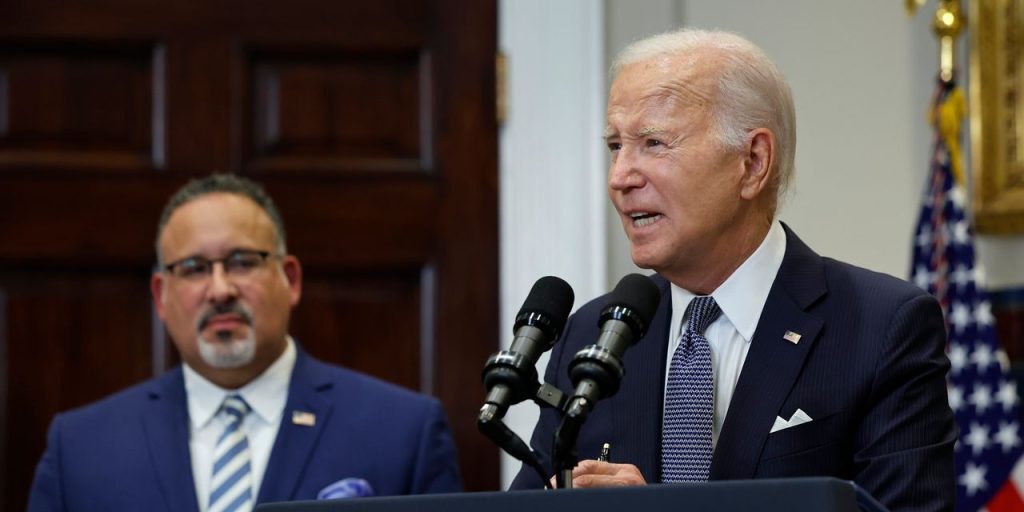Hundreds of thousands of borrowers who have been paying their student loans for decades will have their debt canceled, the Biden administration announced last week.
More than 804,000 borrowers will be impacted by the $39 billion in student-debt relief, officials said.
The announcement comes after years of concern from borrowers and advocates that borrowers would pay their student loans for decades, despite programs that allow borrowers to have their debt forgiven after 20 or 25 years of monthly payments. The Department of Education announced last year that it would review borrowers’ accounts for periods that should have been counted as progress toward forgiveness, but often weren’t due to servicer practices.
Borrowers who are eligible for relief are those that the agency determined have at least 20 years of qualifying payments.
“For far too long, borrowers fell through the cracks of a broken system that failed to keep accurate track of their progress towards forgiveness,” Miguel Cardona, the Secretary of Education, said in a statement announcing the relief. “By fixing past administrative failures, we are ensuring everyone gets the forgiveness they deserve.”
Challenges facing broad student-debt relief
The debt relief announced on July 14 is different from the mass student debt cancellation that’s been occupying headlines for the past several weeks.
In June, the Supreme Court knocked down President Joe Biden’s initial plan to cancel up to $20,000 in student debt for borrowers earning $125,000 or less. If the court had let that relief go through it would have impacted roughly 40 million borrowers regardless of how long they’ve been paying their student loans. Hours after the announcement, Biden vowed to take another stab at debt forgiveness, which officials have said they hope would impact as many of the nation’s more than 40 million student loan borrowers as possible.
By contrast, the cancellation announced July 14 affects more than 800,000 borrowers, all of whom have been in student loan repayment for at least 20 years. The relief aims to address issues that have plagued income-driven repayment. Under these plans, which aim to help borrowers who can’t afford to pay off their debt through mortgage-style payments in 10 years, borrowers make payments based on their income. After 20 or 25 years of these payments, the balance is supposed to be canceled.
But borrowers have historically struggled to get into and stay on these plans. That’s in part because the requirements can be complicated, but also because servicers didn’t provide borrowers with enough or the right information to stay on these plans, according to advocates and lawsuits.
In 2017, the Consumer Financial Protection Bureau and multiple states sued Navient, which then was one of the largest student-loan servicers, accusing the company of pushing borrowers toward forbearance instead of enrolling borrowers in income-driven plans.
Forbearance is a status that pauses student-loan payments, but it can be costly for borrowers: Interest accrues, and months spent in forbearance don’t count as progress toward forgiveness. It’s also often quicker for a servicer to put a borrower in forbearance than to spend the time assisting a borrower in applying for income-driven repayment plans.
In 2022, Navient reached a settlement with 39 states that included $95 million in relief to federal student-loan borrowers over the forbearance-steering claims. At the time, a Navient official said in a statement that the claims addressed by the settlement were “unfounded,” adding that the deal would help the company “avoid the additional burden, expense, time and distraction to prevail in court.”
In its announcement last week, the Department of Education broadly referenced forbearance-steering allegations, saying that the relief “addresses concerns about practices by loan servicers that put borrowers into forbearance in violation” of the department’s rules.
The debt relief recognizes that “after decades of servicer abuses and general mismanagement by the Department of Education … there are millions of borrowers who have been in repayment for decades, and if they had the tools and the support necessary, they would be out of debt now,” said Persis Yu, managing counsel and deputy director of the Student Borrower Protection Center, an advocacy group. “That’s what this group of borrowers is.”
Who is eligible for the debt relief?
To determine who is eligible for relief, the Department of Education combed through borrowers’ accounts looking for months where borrowers may have been building progress toward debt relief, but where that progress wasn’t accurately counted.
Those included months in which a borrower was in repayment even if they made partial or late payments, and regardless of the type of loan or repayment plan. As part of its review, the department also counted months borrowers spent in long-term forbearance, including any month in which a borrower spent 12 consecutive months or more in forbearance, or any month in forbearance for borrowers who spent a cumulative 36 months or more in forbearance.
Borrowers who will have their debt canceled under the initiative don’t have to take any action. The department began notifying eligible borrowers on July 14, and the agency said it would continue to identify and notify qualifying borrowers every two months until next year.
These borrowers have direct loans or federal family education loans held by the Department of Education, and have made at least 240 or 300 qualifying months of payments.
After the agency identifies and notifies borrowers who have been in repayment long enough to qualify for forgiveness under the initiative, it will update the payment counts of other borrowers. For these borrowers, the updated payment count will mean they are closer to having their debt forgiven under an income-driven repayment plan than they were before.
If these borrowers want to continue their progress toward forgiveness after the adjustment is made, they will need to enroll in an income-driven plan — if they’re not in one already.
Borrowers with commercially held family federal education loans need to consolidate their loans by the end of the 2023 to be eligible to have their payment counts updated.
‘Still in clean-up mode’
“One of the things to recognize is that this a huge improvement and obviously life-changing” for the borrowers affected by the relief, Yu said. Nonetheless, she said, “we are still in clean-up mode.”
For example, Yu said, time spent in default doesn’t count as progress toward debt relief under the announcement. “What the [income-driven repayment] account adjustment didn’t remedy is the fact that the worst consequences of these servicing failures and of the abusive practices is that the most vulnerable borrowers defaulted.”
These borrowers, who may have defaulted because they didn’t have access to income-driven repayment, were at risk of being subject to harsh consequences — including garnishment of wages, Social Security and tax refunds.
In addition, the Biden administration recently announced a new income-driven repayment plan that could drastically reduce monthly student-loan payments for many borrowers. But in order for borrowers to access it and other benefits, the Department of Education and servicers will need to implement the program successfully, Yu said.
“A lot of what we need going forward is going to be based upon servicer accountability — ensuring that servicers are properly incentivized to really get borrowers into the programs that are the best for them,” Yu said.
See also: Is now a good time to refinance your student loans? You could save money, but tread carefully.
Read the full article here















